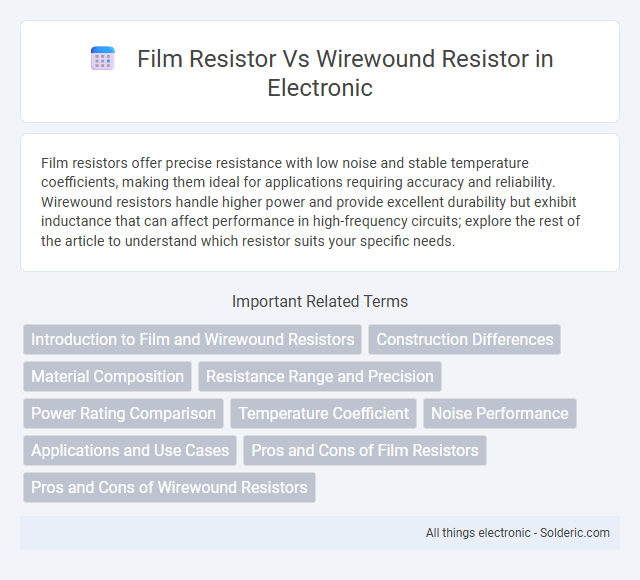Film resistors offer precise resistance with low noise and stable temperature coefficients, making them ideal for applications requiring accuracy and reliability. Wirewound resistors handle higher power and provide excellent durability but exhibit inductance that can affect performance in high-frequency circuits; explore the rest of the article to understand which resistor suits your specific needs.
Comparison Table
| Feature | Film Resistor | Wirewound Resistor |
|---|---|---|
| Construction | Thin film of metal or metal oxide on ceramic base | Coiled wire of resistive material around ceramic core |
| Resistance Range | 1O to 10MO | 0.1O to 100kO |
| Power Rating | 1/8W to 2W | 1W to 50W or higher |
| Tolerance | +-0.1% to +-5% | +-1% to +-10% |
| Temperature Coefficient | Low (+-50 ppm/degC typical) | Very low (+-5 ppm/degC typical) |
| Noise | Low noise | Higher noise due to inductance |
| Inductance | Negligible inductance | Significant inductance |
| Applications | Precision circuits, low power devices | High power, high current, load applications |
| Cost | Generally lower cost | Typically higher cost |
Introduction to Film and Wirewound Resistors
Film resistors consist of a thin resistive film deposited on an insulating substrate, providing precise resistance values and low noise suitable for high-frequency applications. Wirewound resistors are made by winding a metal wire, often nichrome, around a ceramic or fiberglass core, offering high power ratings and excellent stability under heavy loads. Both types serve different roles in electronic circuits based on power dissipation, tolerance, and frequency response requirements.
Construction Differences
Film resistors are constructed by depositing a thin film of resistive material, such as metal oxide, onto an insulating substrate, resulting in a compact, precise, and stable structure ideal for high-frequency applications. Wirewound resistors consist of a metal wire, typically nichrome, tightly wound around a ceramic or fiberglass core, providing superior power dissipation and heat resistance suitable for high-power circuits. Your choice between them depends on the required power rating, tolerance, and frequency response of your electronic design.
Material Composition
Film resistors are typically made by depositing a thin layer of metal oxide or carbon film onto a ceramic substrate, providing precise resistance values and stability. Wirewound resistors consist of a metal wire, often nichrome or tungsten, tightly wound around an insulating core, offering high power dissipation and durability. Your choice depends on whether you need the accuracy and low noise of film resistors or the robustness and heat tolerance of wirewound resistors.
Resistance Range and Precision
Film resistors typically offer a resistance range from a few ohms up to several megaohms with high precision, often within +-1% tolerance, making them ideal for applications requiring stable and accurate resistance values. Wirewound resistors provide a broader resistance range, from fractions of an ohm to several kiloohms, and excel in power dissipation but generally have lower precision, usually around +-5% tolerance. The choice between film and wirewound resistors depends on the required resistance accuracy and operating conditions, with film resistors favored for precision circuits and wirewound types suited for high-power applications.
Power Rating Comparison
Film resistors typically offer power ratings ranging from 0.125 watts to 2 watts, making them suitable for low to moderate power applications. Wirewound resistors can handle significantly higher power levels, often exceeding 10 watts, due to their robust construction with metal wire coils wound on insulating cores. The superior heat dissipation and durability of wirewound resistors make them ideal for high-power circuits requiring precise resistance and stability under heavy loads.
Temperature Coefficient
Film resistors typically have a low temperature coefficient of resistance (TCR), often around +-50 ppm/degC or better, making them stable under temperature variations. Wirewound resistors can offer even lower TCR values, sometimes as low as +-5 ppm/degC, due to their metal wire composition, resulting in superior precision in temperature-sensitive applications. However, wirewound resistors may exhibit inductance that affects performance in high-frequency circuits, unlike film resistors which are generally non-inductive.
Noise Performance
Film resistors exhibit lower noise performance compared to wirewound resistors due to their uniform resistive film, which minimizes microphonic effects and electrical fluctuations. Wirewound resistors generate higher noise caused by inductive elements and mechanical vibrations within the wire coil, leading to unwanted signal distortion in sensitive circuits. Choosing a film resistor can improve Your circuit's signal-to-noise ratio and enhance overall noise immunity.
Applications and Use Cases
Film resistors are ideal for precision applications such as audio equipment, instrumentation, and low-noise circuits due to their stable resistance and low noise characteristics. Wirewound resistors excel in high-power applications, including power supplies, motor controls, and load testing, where they can handle higher currents and dissipate more heat. Your choice between the two depends on whether accuracy and low noise or power dissipation and durability are the critical requirements for your project.
Pros and Cons of Film Resistors
Film resistors offer precise resistance values, low noise, and excellent stability over temperature changes, making them ideal for precision electronic circuits. Their non-inductive construction reduces electromagnetic interference, but they generally have lower power ratings and less robustness compared to wirewound resistors. Film resistors are cost-effective and suitable for high-frequency applications, whereas wirewound resistors excel in high-power scenarios but can generate inductance issues.
Pros and Cons of Wirewound Resistors
Wirewound resistors offer high precision and excellent power dissipation, making them ideal for applications requiring stability under high temperatures and heavy loads. However, their inductive nature can cause issues in high-frequency circuits, and they tend to be bulkier compared to film resistors. If your design demands low noise and minimal inductance, a film resistor may be more suitable than a wirewound resistor.
Film resistor vs wirewound resistor Infographic

 solderic.com
solderic.com